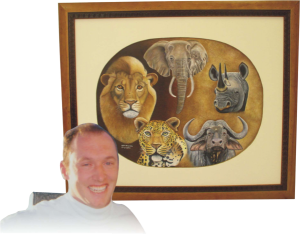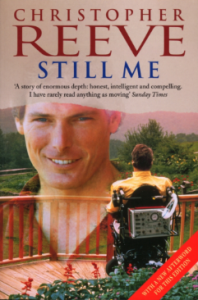Art & Creative Writing
Contents: To jump to the topic you would like, click on the links below
Introduction
Art & Creative Writing are both great hobbies because, they are not only enjoyable, but also a form of therapy, a form of escapism and can also be a way to make money. Creative Writing does not cost anything, except an initial outlay if you need a computer or computer aids and don't have them. Many of the hobbies that are considered Art are relatively inexpensive, but may cost a bit to get started. Some people with severe physical disabilities often feel that they are trapped inside their bodies. You can learn to express yourself through your art.
For the most part Art & Creative Writing are still possible even if you have a mobility impairment. If you have severe Mobility Impairment, which effects the use of your hands, but still have use of your arms, you can still learn to write, draw, paint or create other art, with the use of an assistive device or brace to hold a pen, pencil, paintbrush or tool in place. Most Mobility Impairments will not prevent you from enjoying some form of Art or Creative Writing. For those who do not have use of their arms, Foot or Mouth Painting and creating Art or Creative Writing with the aid of a computer are also options. (See Computer Aids for assistance.)
Other benefits of Art & Creative Writing include:
- helps an individual regain a feeling of self worth - they feel that they can create something and can experience the joy of creating their own art.
- is a good way to educate others, how people with disabilities, who cannot walk or talk and have limited or no use of their hands can still create something beautiful.
Creative writing is any writing that goes outside the bounds of normal professional, journalistic, academic, or technical forms of literature. Both fictional and non-fictional works fall into this category, including such forms as novels, biographies, short stories, and poems.
There are also many inspirational people out there, who are mobility impaired and have written books on how they have dealt with their disabilities. Some of these people were famous before they became disabled. An example of this is Christopher Reeve, who wrote books, such as "Still Me" & "Nothing is impossible."
Others like Christy Brown who became famous from their Creative writing and who only had the use of the toes of one foot, and was an Irish writer and painter who had cerebral palsy and was able to write or type only with the toes of one foot. His most recognized work is his autobiography, titled My Left Foot (1954). It was later made into a 1989 Academy Award-winning film of the same name.
Either way many of these books are helpful and inspirational to others and can be therapeutic to the person writing the book.
Creative writing can be handwritten or typed on a computer. Thanks to the wide variety of computer aids available for the Mobility Impaired, this is probably the best option, however some people still prefer writing by hand. If this is the case and your hands are effected by your Mobility Impairment, you may need the use of a brace.
There are a wide variety of types and styles of these braces that can be made by an Occupational Therapist to suite you and your needs. In many cases they will need to be fitted and molded to your hand. In some cases, a person can develop techniques, so that they can do away with a brace that they used to use & still be able to write. I don't have any movement in my fingers, so for years, I used a brace to write with, which someone had to put on for me. I eventually developed a technique to be able to write without a brace. I fitted the pen between my fingers. A thicker pen or tape on a pen can also help.
Art
Art can include a number of activities such as:
Some activities may not be possible because of the type of Mobility Impairment that you have, but you need to focus on the things you can do, rather than the things you cannot. Everybody is different, and you will need to find your own style or way of painting, etc. Below are a few of these activities.
Many people with Mobility Impairments, including myself turn or tuned to Drawing & Painting as a hobby. I was a disabled artist for about 12 years and spent almost every day drawing or painting. It helped me to deal with my disability, was a form of escapism and I was able to make some money from my Art. It also helped me regain a feeling of self worth, felt that I can create something and experienced the joy of creating art.
After I was paralyzed from the chest down, I began drawing & painting, as I had always enjoyed art when I was younger & I realized that this was something I could do despite my disability. You do not lose that ability.
As I have limited use of my hands due to my injury, I used a brace that fits onto my hand, which an Occupational Therapist made for me. This holds the pencil or paintbrush in the correct position so that I can draw or paint. I also used a Draughtsman table, to work from, it tilts, so that I can rest my elbow, which gives me more control, but makes it more difficult if you wish to paint large size paintings. An easel will solve this problem and used by most Mouth Painters.
Many people with my level of Mobility Impairment chose to do Mouth Painting (see below), but I chose to use a brace and developed quite a bit of control.
There are a variety of different mediums to chose from, including water colours, Acrylic or Oils. If painting is new to you, you may need to experiment with different mediums and styles to find something that suites you and your Mobility Impairment.
Foot & Mouth Painting
Foot & Mouth Painting is a technique to create drawings, paintings and other works of art by maneuvering brushes and other tools with the mouth or foot. The technique is mostly used by artists who through illness, accident or congenital disability have no use of their hands. The Association of Mouth and Foot Painting Artists (AMFPA) is a worldwide organization representing these artists.
The brushes and tools that are used are ordinary artist's implements, but they may be modified in length or width. Mouth painters hold the brush in their mouth or between their teeth and maneuver it with their tongue and cheek muscles. The paper or canvas is usually mounted vertically on an easel. Mouth painting is strenuous for neck and jaw muscles since the head has to perform the same back and forth movement as a hand does when painting. Even individuals who are bedridden can do Mouth painting and many of these artists produce amazing works.
Foot painting can be done sitting on the floor, at a table or at an easel, as most foot painters use their toes with the same dexterity as people with hands use their fingers. Many of these artists have limited or no use of their hands, but use of their legs, while some like Christy Brown has only the use of the toes of one foot, such as Christy Brown, who was an Irish writer and painter who had cerebral palsy and was able to write or type only with the toes of one foot. His most recognized work is his autobiography, titled My Left Foot (1954). It was later made into a 1989 Academy Award-winning film of the same name.
Some Foot & Mouth Painters get the opportunity to join the Association of Mouth and Foot Painting Artists of the World (AMFPA), which is a for-profit international organization facilitating the sale of artwork produced by mouth and foot painting artists associated with the organization. None of the artists have proper use of their hands as a pre-condition to joining the association. It represents around 820 artists located in 76 countries, of which 143 (as of 2016) are members and thereby receive a monthly fee from the organization from the date of their admission until their death. The other artists are students who receive a monthly scholarship unless they are promoted.
The main product of the organization is Christmas cards with motifs painted by the member artists. These cards are sold every year in the months leading up to Christmas via direct mailing in 48 countries around the world (as of 2016). Other products include postcards, art prints and calendars.
The parent company in Liechtenstein acquires the reproduction rights of a given painting and distributes it internationally. The original works are also sold at exhibitions held throughout the world.
Sculpturing is also an option for individuals with Mobility Impairment, although it can be difficult with limited hand function, but is not impossible. Besides painting, I have also tried my hand at clay sculpture, which I then painted using Acrylics. It takes more time and requires more effort, you will need to be able to fit different tools into your hand brace and may need help changing them, but it is possible.
Cartoons, Caricatures & Computer Art
Cartoons, Caricatures & Computer Art is another way that you can express yourself artistically. In recent years I hung up my paint brushes & concentrated on my business of Graphic & web site design, but continued to express myself creatively in my cartoons, caricatures & illustrations, all using my computer, a program called Coral Draw along with many of the Computer Aids mentioned in that section. Visit "A Laugh at Life" to see some samples. The cartoons are mainly about Disability and lack of access. Creating them helped me deal and express my frustrations with many of the problems that the Disabled face. Some people with Mobility Impairments are able and chose to use a stylus pen or other software, such as Photoshop, Adobe Illustrator, etc.
There are many other types of Computer Art and you are only limited by your imagination.
Pottery, Wood Carving & Beadwork
Although I have never tried Pottery, Wood Carving or Beadwork, I know of some Quadriplegics & Paraplegics who have, and have had great benefits. These 3 hobbies require more hand function than I have as a C5 Quadriplegic, however I do know of other C5 Quadriplegics who have managed to do these hobbies. Many Occupational Therapist strongly endorse beading, wood carving & pottery as an excellent leisure activity, which helps adults and promotes children's development in the following areas:
- Beadwork Improves Fine Motor Skills, like grasping various sizes of beads to promote different grasps.
- beading, wood carving & pottery improve In-hand manipulation skills: Many components of making a beaded craft increase strength and coordination in the small hand and finger muscles, while manipulating clay and working with a variety of tools to shape wood also increase strength and coordination in the hands.
- Visual Perceptual Skills in children: The child doing beading must remember the beading pattern and select the bead that fits their mental image of the desired bead. Finally, the child must scan across many different beads before finding the desired bead.
- Visual Motor Skills: Eye-Hand coordination: Threading beads onto a string involves bilateral coordination of the persons hands, and requires their eyes and hands to work together.
- Cognitive Skills: Like planning what to create from a block of wood, lump of clay, or what style of necklace a person would like? What pattern will they choose? What materials are needed to complete this beading activity? By answering these questions, the child develops his/her planning and problem-solving skills.
- Math Skills: How long will my necklace, bracelet, or keychain need to be? How many beads do I need to complete this project? How can I create and maintain this beading pattern? Encouraging children to think through these functional math problems is a motivating way to improve academic skills in this area.
- Social Skills: These hobbies can often be enjoyed in workshops or groups, so encourage socializing. Beading Parties promote sharing and cooperation, as children choose beads and complete their projects in a group setting.
Last but not least, these hobbies provide a sense of accomplishment in completing a project that offers freedom of self-expression and camaraderie with others. This sense of "Occupational Fulfillment" can contribute to improved self-esteem.
Earning a Living through Art & Creative Writing
Although Art & Creative Writing are hobbies, they can also be a way that you can earn money through commissions, or you can sell your art privately, at Flea markets or in exhibitions. During my 12 years of painting I exhibited and sold quite a few artworks in exhibitions that QASA holds every year in different cities around South Africa. I have also sold a couple of paintings privately.
Some Foot & Mouth Painters get the opportunity to join the Association of Mouth and Foot Painting Artists of the World (AMFPA). Members receive a monthly fee from the organization from the date of their admission until their death. The other artists are students who receive a monthly scholarship unless they are promoted.
Some people out there, who have mobility impairments write poems or articles for magazines, for money, while some have written books about their lives and how they have dealt with their disabilities. Some of these people were famous sports stars or actors, before they became disabled. An example of this is Christopher Reeve, who wrote books, such as "Still Me" & "Nothing is impossible."
While others like Christy Brown who became famous from their Creative writing. His most recognized work is his autobiography, titled My Left Foot (1954), which was about his life as an Irish writer and painter who had cerebral palsy and was able to write or type only with the toes of one foot. It was later made into a 1989 Academy Award-winning film of the same name.
Either way many of these books were not only helpful and inspirational to others, but also able to earn them money.





